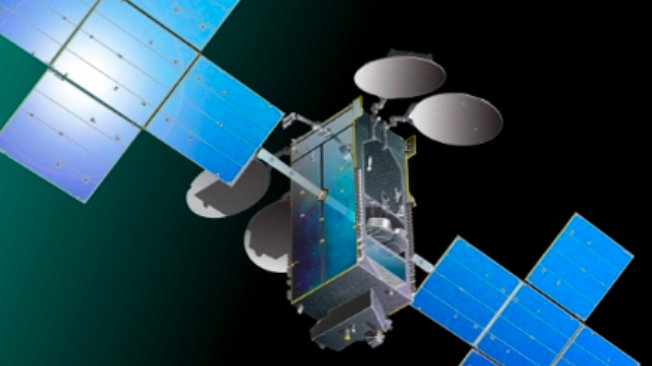
The ultrahigh density JUPITER 3 (EchoStar XVII) satellites will launch in 2022. (Graphic: Hughes)
SATELLITE 2022: Hughes Network Systems has scored an $18 million contract to create a satellite-enabled 5G wireless network at Whidbey Island Naval Station, Washington, as part of the Pentagon’s high priority experimental effort to bring modern, high-speed connectivity to bases around the country, the telecommunications firm announced today.
“Over the course of this three-year project, we will demonstrate for the U.S. Department of Defense how 5G infrastructure from Hughes — including a packet processing core, radio access, edge cloud, security and network management — can power the resilient networking necessary to transform base operations,” said Rajeev Gopal, Hughes vice president for advanced programs, in the company’s announcement.
“Today’s walkie-talkies, paper-trails and telephone conversations will be replaced with a private, secure 5G network over which air station processes and systems will be automated and continuously optimized,” he added.
Hughes will serve as the prime contractor developing the standalone 5G network to support operations, maintenance and flight traffic management at the naval air station. The new 5G network will utilize spectrum from DISH Wireless, and will leverage satellites in both Geosynchronous and Low Earth Orbits (GEO/LEO).
In GEO, the network will tap the JUPITER high throughput satellites (built by Hughes’ parent firm EchoStar), including the new, ultrahigh density JUPITER 3 that will extend domestic coverage from coast to coast and provide download speeds of over 100 Mbps, Gopal told Breaking Defense in an email.
“For LEO, Hughes has already tested the OneWeb LEO in the challenging Arctic area,” he added. Once the full constellation is on orbit, “OneWeb LEO and its inherent latency advantages for 5G networks would create a global service for maximum coverage over oceans and landmasses.”
OneWeb’s launch schedule hit an unexpected challenge this month, with Russia refusing to let the systems launch as planned on a Soyuz rocket unless the firm pledges that no country will use its internet satellites for military purposes. On March 4, Russia removed a Soyuz carrying OneWeb’s next 36 satellites from the launchpad at Baikonur Cosmodrome in Kazakhstan, which is managed jointly by the Russian Aerospace Forces and Roscosmos, Russia’s space agency.
However, an alternative appears to have been found: OneWeb announced today that the company and SpaceX have entered into an agreement that will enable OneWeb to resume satellite launches. The first launch with SpaceX is anticipated in 2022, but the full extent of the launch agreement hasn’t been disclosed. OneWeb currently has 428 satellites on orbit, or 66 percent of it’s planned constellation of 648 satellites
Cybersecurity is another key attribute that the Hughes 5G network will provide, Gopal explained in his email.
“Security and management are key to fully benefiting from 5G capability for an enterprise or private implementation. For DoD applications, 5G needs high levels of cybersecurity. Stand-alone 5G networks, like the Hughes network, are inherently more secure than older networks where 5G is added onto the existing network,” he said. “Hughes is using a modern Zero Trust Architecture (ZTA) that provides fine grained authentication and encryption even within the network parameters. The Hughes architecture is also compatible with Commercial Solution for Classified (CSfC) that has been designed by NSA.”
The new 5G contract is an Other Transaction Agreement (OTA), issued through the Information Warfare Research Project (IWRP) consortium of industry and academia, and aimed at helping the Navy and Marine Corps develop and mature technologies related to information warfare. But the effort is actually part of the Defense Department’s multifaceted 5G experimentation initiative, called the Next Generation Information Communications Technology program, that involves numerous service bases — in this particular case, Joint Base Pearl Harbor-Hickam.
That initiative was launched in 2019 by then-head of DoD’s Office of Research & Engineering Mike Griffin, who declared development of 5G technologies a top priority for the office. In 2020, the Pentagon issued contracts to 15 vendors worth approximately $600 million for network building at five military bases, and in 2021 issued solicitations for another seven bases in 2021 to bring the total to 12.
In its fiscal 2022 budget request, the Pentagon sought a total of $393 million for 5G research: $375 million for the base experiments, and another $23 million to fund the “Beyond 5G” program. The Beyond 5G program is looking to future generations of wireless capability and is being conducted in partnership with the National Institute of Standards and Technology and the National Science Foundation.
Heidi Shyu, the current R&E head, told reporters in January that she is interested in setting standards for 6G and even 7G, and that to that end she has hired a “director of next-G.”






















